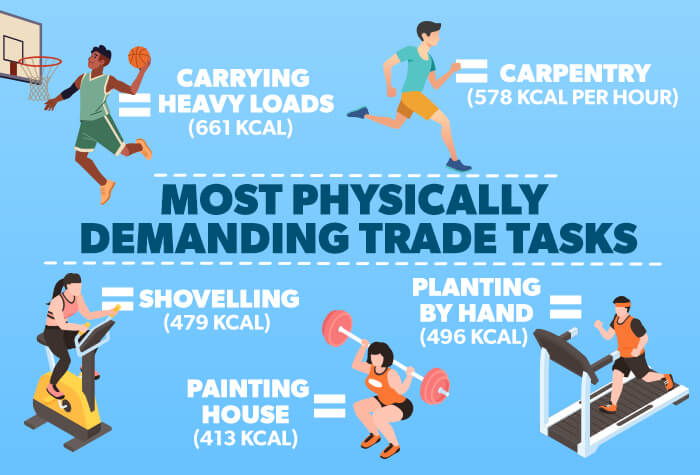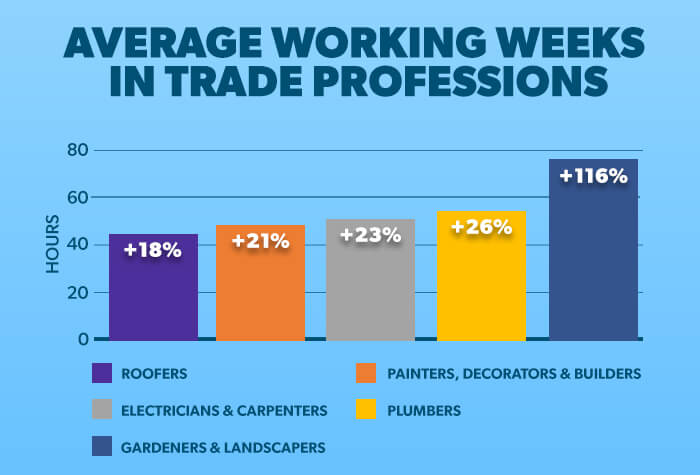Roofers burn more calories than world champion boxers

How Does Working as a Tradesperson Compare to a Gym Session?
Hardworking tradespeople burn more calories every day than many professional sportspeople, new research has revealed.
We've taken an in-depth look into the most strenuous jobs in the trade. Our research found that some tradespeople, including roofers, labourers, carpenters and painters are burning more calories on a daily basis than a professional boxer training for a high-profile bout.
The research found boxers burn through around 800 kcals an hour in the build-up to a big fight, generally training for around four to five hours a day. Tradespeople carrying heavy loads such as roofers, meanwhile, burn 661 kcals an hour – but they typically do this for a longer period than five hours each day. According to Selco’s research, roofers work an average of 43 hours a week.
Roman Fury, brother of WBC heavyweight champion Tyson Fury, moved to 4-0 as a pro boxer by beating Martin Svarc on points in Saudi Arabia on the Anthony Joshua vs Francis Ngannou undercard.
The former tradesperson, who is sponsored by Selco, said: “It was a good a victory over an undefeated fighter. I'm enjoying it, I've been pro for two years now and I'm riding the wave. It’s hard work but, as a former roofer and bricklayer myself, I know how strenuous the job is so I’m not at all surprised by these findings. It’s no wonder there are some extremely fit people in the trades when they are so physically active on a daily basis.”
Fury weighed in for his recent bout at 101.65kg. A man of his size can expect to burn 587 calories each hour while pounding a punch bag, 833 kcal when sparring, or a whopping 1,366 kcal when fighting in the ring.
Heavy effort carpentry, meanwhile, uses 578 kcal per hour, the equivalent of 60 minutes of jogging, while planting by hand expends 496 kcal, comparable to a 60 minute cardio workout. Shovelling is also similar to a 60 minute cardio workout at 479 kcal, while painting the outside of a house uses 413 kcal, the equivalent to a medium-effort resistant training workout such as squats, lunges or deadlifts. Masonry professionals, though, may need to supplement their job with gym work. An hour of masonry uses 355 kcal, comparable to 60 minutes of curling.
Alison Wong, head of communications and sustainability at Selco, said: “The NHS recommends that each adult aged between 19 and 64 years should do least 150 minutes of moderate intensity activity such as brisk walking or 75 minutes of vigorous intensity activity such as running a week, meaning many tradespeople could have already done their recommended amount of weekly physical activity before lunchtime on Monday!”

We calculated how many calories are burned when completing tasks commonly performed by tradespeople. We did this by looking at estimated MET values (used to indicate energy expenditure) for each activity. We then looked at how these compared to other popular physical activities such as running, team sports or gym workouts.
We also investigated which trade careers require the longest hours compared to the national UK average and are therefore more likely to be really physically demanding.
Most physically demanding trade tasks:
- Carrying heavy loads: 661 kcals, the equivalent of an hour-long basketball game
- Carpentry: 578 kcal per hour, the equivalent of 60 min of jogging
- Planting by hand: 496 kcal, comparable to a 60-minute cardio workout
- Shovelling: 479 kcal, comparable to a 60-minute cardio workout
- Painting house – outside: 413 kcal, comparable to a 60 min medium-effort resistance training workout (squats, lunges, deadlifts etc.)
- Masonry: 355 kcal, comparable to 60 mins of curling

How many hours do tradespeople work compared to the UK average?
It’s no secret that many tradespeople work longer hours than a lot of other careers, but how many does this amount to exactly? To find out, we sourced data from the Trades Union Congress on the number of hours commonly worked per week by tradespeople, and then we compared this to UK average for all types of employees.
The data has shown gardeners and landscapers currently have the longest working week amongst tradespeople, and generally put in more than double the number of hours ‘on the job’ compared to the average UK employee.
In fact, tradespeople in this field generally work 79 hours a week, while the average UK employee puts in around 36.5 hours in a week, according to the ONS. This means working weeks for gardeners and landscapers are 116% longer than average.
Following closely are plumbers, working an average of 46 hours a week (26% more than the national average) and carpenters and electricians, who work 45 hours a week on average (23% more than the average UK employee).
Average working weeks in trade professions
- Gardeners/landscapers (79 hours, +116% more than the national average)
- Plumbers (46 hours, 26% more)
- Electricians and carpenters (45 hours, 23% more)
- Painters/decorators and builders (44 hours, 21% more)
- Roofers (43 hours, 18% more)

What can tradespeople do to take care of their bodies while working and avoid injuries?
So, we know that being a tradesperson is hard graft – not only because it’s often really physically demanding, but also because the days and working weeks are usually really long too. So, how can injuries be avoided?
Well, back and shoulder injuries are pretty common amongst tradespeople, as reported in a recent survey that claimed nearly two thirds (60%) reported lower back injuries last year, while shoulder ache (31%) was found to be the second most likely pain to trouble tradespeople.
Furthermore, according to research by UNISON, one in three accidents at work are caused by manual handling, and every year, 300,000 people in the UK suffer from back pain due to manual handling accidents.
And if that’s not enough, according to data on injuries at work from the HSE, 18% of the 441,000 non-fatal injuries sustained by UK workers in 2020/21 were from handling, lifting and carrying objects.
According to the HSE, professions such as skilled construction and building trades are one of the occupations with the highest estimated prevalence of back injuries and upper limb disorders.
Manual handling is the most commonly reported cause of injuries lasting over seven days in the industry. Construction also has one of highest rates of ill health caused by noise and vibration.
It's really no surprise that the physical toll of manual labour can expose people in the 'trades' to injuries, especially when it comes to musculoskeletal ones (those affecting the bones, muscles, ligaments, nerves or tendons).
For this reason, as part of our research, we spoke to personal trainers to find out more about ways tradespeople can take care of their bodies while working, as well as which warm-up exercises to try before starting the working day, to avoid potential injuries.
Expert advice from a personal trainer
According to James Bickerstaff, Personal Trainer at OriGym: “Working a manual job for prolonged hours a day can produce results equivalent to a gym-based workout.
"On average, in fact, a 170lb adult can expect to burn up to 134 calories per hour just from standing, so a manual labour job which requires the person to stand for 8 hours could see you burn up to 1648kcal every day just by standing alone!”
This is why it’s really important for tradespeople to be aware of potential injuries and risks associated with the job, and take all precautions to ensure their day-to-day work has no repercussions on their physical health. The experts recommend the below:
- Don’t just rely on your body!
First, never attempt to lift extremely heavy loads alone. If you struggle, ask for the assistance of a colleague, or find a piece of equipment designed for lifting. This can include the likes of turntables, hoists, and trolleys, none of which will rely on your body strength. - Try some warm-up exercises.
Prior to starting your day, we’d strongly recommend focusing on warm-ups which target your core (abdominals, obliques, lower back, hip flexors and glutes). This is because these are the muscles which will help you perform activities such as bending, reaching, lifting and pushing. Some core warm up exercises you can do include the likes of planking, back bridges and side planks, all of which can be done in as little as 10 minutes. These warmups will ensure that your back and midsection are toned and prepared for manual responsibilities such as heavy lifting. Which in-turn can protect you from any unwanted injuries or strains that could occur whilst on the job. - Try exercising outside of work too!
By far the best piece of advice we can provide is to ensure that you work on strengthening major muscle groups and smaller stabilising muscles through strength or resistance training. This is because manual jobs can cause repetitive stress to the muscles, bones, and joints. Strength and resistance training can counteract these stresses and promote a stronger healthier body. Just be sure to focus on the likes of your glutes, back, chest, shoulders, arms, and core by exercising two-three times a week on non-consecutive days.